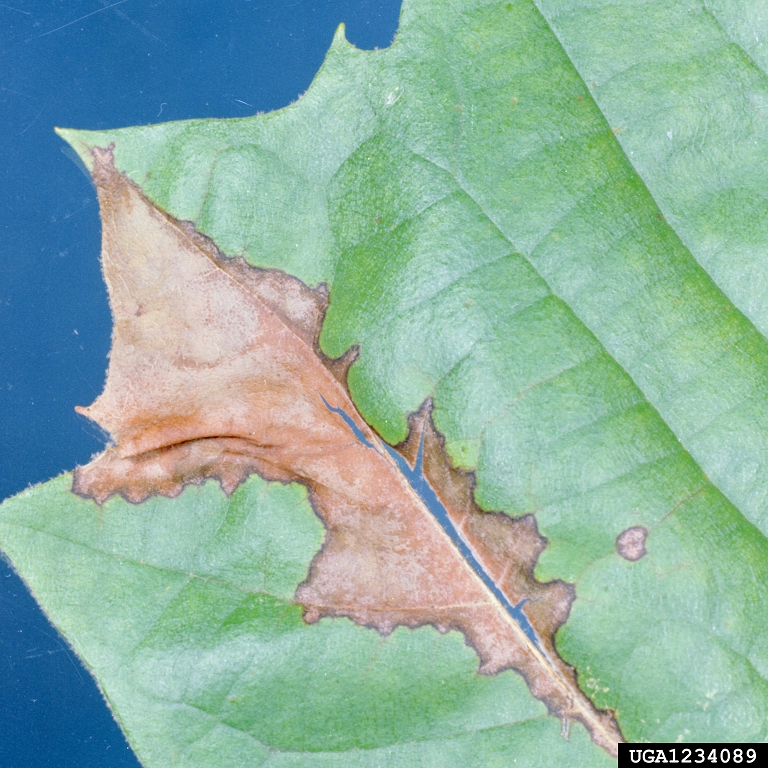 London Plane Trees Are Awesome - September 4, 2019 Jeff Schalau, Agent, Agriculture & Natural Resources University of Arizona Cooperative Extension, Yavapai County The London plane (Plantanus x acerifolia) is a large landscape tree that is widely planted in landscapes, parks, and streets in north central Arizona. It is well-adapted for planting in temperate climates worldwide from Johannesburg, South Africa to Sydney, Australia. Most horticulturists believe the London plane is a hybrid between American sycamore (P. occidentalis) and the Oriental plane (P. orientalis). At maturity, the London plane is often 60-80 feet wide and can be 50-60 feet tall. However, northern Arizona specimens are not usually this large. Given its size, care should be taken to plant a London plane in a space where it can fully express it’s beauty. This includes keeping it 30 feet away from structures and providing ample rooting space and avoiding areas with underground utilities. They have also been known to lift sidewalks and patio slabs when planted too close. London plane trees need full sun and are hardy to USDA Plant Hardiness Zone 5 (lows of -20 degrees F). These trees do tolerate the alkaline soils found across Arizona and require regular irrigation. However, I’ve observed large specimens of London plane in Yavapai County that seem to survive with little irrigation beyond natural rainfall once they have become established. A case in point are the London planes planted along Gurley St. in from of the Sharlot Hall Museum in Prescott, AZ. London plane trees tend to be a somewhat messy, seemingly dropping something every day of the year. In fall, when other deciduous trees are dropping their leaves, the London plane leaves die, but persist on the branches throughout the entire winter. Many leaves may drop on a windy winter day, but many seem to hang on for months. London planes also have interesting spherical fruits which when broken apart hold hundreds of fluffy seeds. Sycamore trees have very interesting and attractive, mottled bark. On the older, lower portions of the tree, it may be darker, rough and furrowed. Higher up, it is usually thin, smooth, ashy white, and flakes off to show mottled colors of greenish white, tan, and brown. To me, this is the best feature of sycamore trees. The London plane seems to have more rough, dark bark at the base than our native sycamores. Knowing your leaf shapes will help you distinguish between the London plane and native sycamores of the western U.S. All sycamores have palmately lobed leaves – meaning the leaf resembles an open hand with lobes radiating from a common point. I think most people have seen the palmately lobed maple leaf on a Canadian flag. The London plane has “toothed” lobes which means the edges of each lobe have some small pointy shapes. The native sycamores of California (P. racemosa) and Arizona (P. wrightii), have smooth, untoothed lobes making them easy to differentiate from the London plane. The Arizona sycamore is abundant along the Verde River and its tributaries (Oak Creek, Beaver Creek, West Clear Creek, and others). However, it seems to be less adapted to being planted in dry upland sites and always looks its best when growing in a riparian area. I do not recommend this plant for residential or commercial landscapes – especially where there may be intense, reflected heat or where gravel mulch is used. I have included a link describing the Arizona sycamore below. If you get out and explore, visit the Arizona sycamore at the outlet of Montezuma Well in Rimrock, AZ along the edge of Wet Beaver Creek. It is leaning at a 45-degree angle and has the most exquisite bark of any tree I’ve seen. It will make a tree hugger out of you. All sycamores can get a fungal disease called anthracnose. It is especially prevalent following a cool moist spring (such as the spring of 2019). As the new leaves emerge in spring, anthracnose causes them to have dead areas along the leaf veins. As the symptoms progress, twig ends often die back 8 to 10 inches. After years of chronic infections, cankers may form on the branches and trunk. In my experience, Sycamore anthracnose is seldom serious in north central Arizona due to the hot, dry weather we experience in May and June. I have included anthracnose photos and a reference below. If you have the space, consider planting a London plane tree! You can follow the Backyard Gardener on Twitter – use the link on the BYG website. If you have other gardening questions, call or email the Master Gardener help line in the Prescott (928-445-6590/prescottmg@gmail.com) or Camp Verde (928-554-8992/verdevalleymg@gmail.com) and be sure to include your name, address and phone number. Find past Backyard Gardener columns or provide feedback at the Backyard Gardener web site: http://cals.arizona.edu/yavapai/anr/hort/byg/. Photos  London plane tree on Gurley St. in Prescott, AZ near the Sharlot Hall Museum. Leaves and fruit are shown in the upper left photo and the bark is shown in the upper right photo. (Platanus x acerifolia, Jeff Schalau, University of Arizona).
London plane tree on Gurley St. in Prescott, AZ near the Sharlot Hall Museum. Leaves and fruit are shown in the upper left photo and the bark is shown in the upper right photo. (Platanus x acerifolia, Jeff Schalau, University of Arizona). Foliar symptoms of sycamore anthracnose (Apiognomonia veneta, Clemson University - USDA Cooperative Extension Slide Series, Bugwood.org).
Foliar symptoms of sycamore anthracnose (Apiognomonia veneta, Clemson University - USDA Cooperative Extension Slide Series, Bugwood.org).Additional Resources Sycamore anthracnose, Colorado State University Extension extension.colostate.edu/topic-areas/yard-garden/sycamore-anthracnose-2-930/ Arizona Sycamore, Yavapai County Native and Naturalized Plants cals.arizona.edu/yavapaiplants/SpeciesDetail.php?genus=Platanus&species=wrightii |